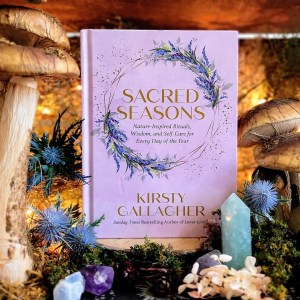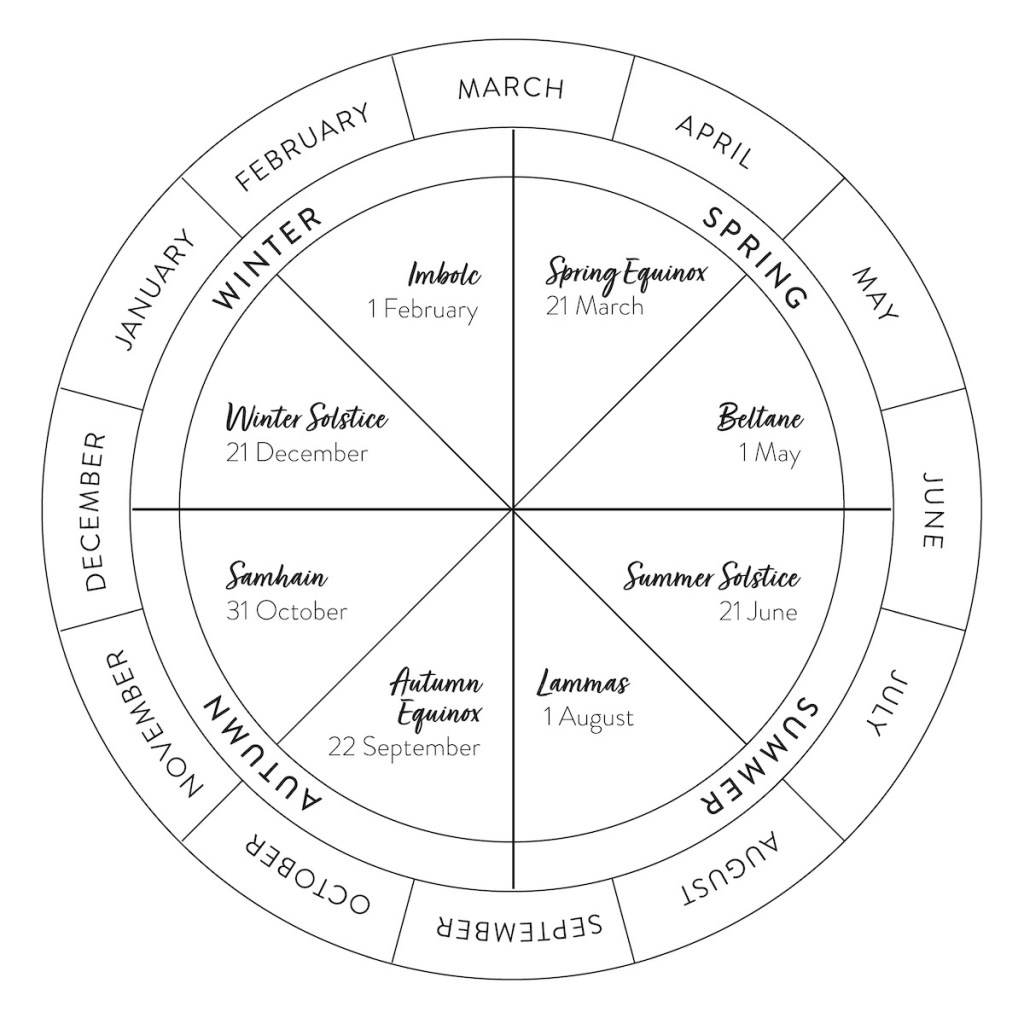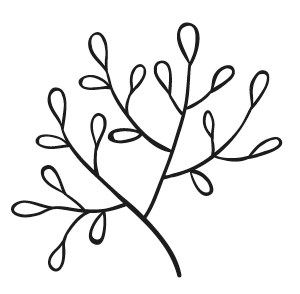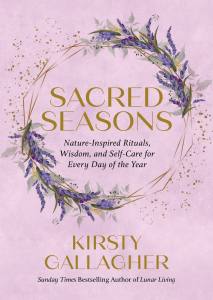Get to Know the Wheel of the Year: An Excerpt of Sacred Seasons by Kirsty Gallagher

Here on RP Mystic, we offer a wide range of rituals to help you celebrate the sabbats along the Wheel of Year. But what exactly is the Wheel of the Year? How did it come to be, and why are these dates important? The upcoming book Sacred Seasons: Nature-Inspired Rituals, Wisdom, and Self-Care for Every Day of the Year by Sunday Times bestselling author Kirsty Gallagher answers these questions and more!
London-based modern mystic Kirsty Gallagher is a moon mentor, soul alignment and transformation coach, yoga teacher, and meditation teacher with an infectious passion for life. She is also the founder of the online sisterhood Lunar Living, which teaches you how to weave the secret and ancient wisdom of the moon into modern, everyday life.
Enjoy this exclusive excerpt from Chapter 2 of Sacred Seasons as we await its release on June 13th. Pre-order your copy at your favorite bookseller today.
A note from RP Mystic: As of this writing, the next sabbat is Litha, celebrating the Summer Solstice, on June 20th. Prep early with our guest post from Practical Magic author Nikki Van De Car, “Celebrating Litha.”

Getting to Know the Seasons and the Wheel of the Year
In this book, I will weave the wisdom of Nature with the Wheel-of-the-Year celebrations and astrological seasons, taking you on a year-long journey to come back into alignment—not only with Nature, seasons and cycles, but also with yourself.
Just as we, at our very essence, are connected to Nature, her seasons and cycles are intrinsically connected to the Wheel of the Year and the astrological seasons.
As the earth moves around the sun (at a slight slant, which is what gives us seasons), the sun, from our vantage point on earth, appears to move through the sky, along what is known as the ecliptic. The constellations of the zodiac run just above the ecliptic, meaning that, throughout the year, the sun moves through each sign of the zodiac. It is the date the sun goes into the cardinal signs of the zodiac (Aries, Cancer, Libra, and Capricorn) that marks the solstices and equinoxes, and this, in turn, marks the beginning of Nature’s seasons.
Throughout this book, I will refer to the astronomical seasons, which use the dates of the solstices and equinoxes to mark the beginning and end of each of Nature’s seasons. In astronomy, for example, spring begins on the day of the spring equinox, when the sun moves into Aries (approximately 21 March) and runs until the summer solstice, when the sun moves into Cancer (approximately 21 June). According to the meteorological seasons, however, spring runs from 1 March to 31 May.
The date the sun moves into the different zodiac signs (and therefore the dates of the solstices and equinoxes) can shift by a day or so either side, year on year. This is because we count a calendar year as 365 days (or 366 in a leap year), but the earth takes 365.24 days (or 365 days, 5 hours, and 48 minutes) to orbit the sun.
Leap years were created to compensate for that extra quarter of a day/six hours a year to better match our calendar year with the solar year, and keep the seasons, solstices, and equinoxes in line with the calendar. But those leap years every four years mean the day and time the sun shifts into the different signs can move by a day or so.
It is also worth briefly mentioning here the difference and relationship between astrology and astronomy: astronomy is the scientific study of the stars, planets, and the galaxies; astrology is the study of how the movement of these planets and stars influences human life. Astronomy and astrology were studied together until the seventeenth century when they were separated into two disciplines. Note: the seasons in the northern hemisphere are the opposite of those in the southern hemisphere. So to my southern-hemisphere friends: please adapt the seasons where necessary. Now that we know a little more about how Nature’s seasons connect with the Wheel of the Year and the astrological seasons, let’s take a look at this in slightly more depth.

The Wheel of the Year
The Wheel of the Year consists of eight annual celebrations that mark the turning of the seasons. These moments of pause between seasonal shifts keep us connected to Nature and give us an anchor through which we may pause, reflect, give thanks, and make conscious changes in our own lives before moving into a new season.
There are four fixed quarter points in the year: two solstices and two equinoxes. These represent the beginning of a new season and are celebrated on the day when the sun moves into the cardinal zodiac signs. The four quarter points are then crossed again by the four cross-quarter festivals; these fall at the peak of each season at the exact astrological midpoint between the solstices and the equinoxes.
Here is a list of the eight celebrations:
Spring equinox (Ostara):
20–23 March (northern hemisphere)
20-23 September (southern hemisphere)
Sun 0˚ Aries
Beltane:
1 May (northern hemisphere)
31 October (southern hemisphere)
Sun 15˚ Taurus
Summer solstice (Litha):
20–23 June (northern hemisphere)
20–23 December (southern hemisphere)
Sun 0˚ Cancer
Lammas (Lughnasadh):
1 August (northern hemisphere)
1–2 February (southern hemisphere)
Sun 15˚ Leo
Autumn equinox (Mabon):
20–23 September (northern hemisphere)
20–23 March (southern hemisphere)
Sun 0˚ Libra
Samhain (Halloween):
31 October (northern hemisphere)
1 May (southern hemisphere)
Sun 15˚ Scorpio
Winter solstice (Yule):
20–23 December (northern hemisphere)
20–23 June (southern hemisphere)
Sun 0˚ Capricorn
Imbolc:
1–2 February (northern hemisphere)
1–2 August (southern hemisphere)
Sun 15˚ Aquarius
THE SOLSTICES
The word solstice means stopping or standing still, from the Latin words solstitum—sol (sun) and stitum (to stop).
The summer solstice occurs in June when the sun is at its farthest north and highest point in the sky, bringing us the longest day of the year and marking the start of summer. The winter solstice occurs in December when the sun is at its farthest south and lowest point in the sky bringing us the shortest day of the year and marking the start of winter. These days—at the midpoint and end of the traditional year—are the ideal time to be still and check in with where you are.
THE EQUINOXES
The word equinox means equal, from the Latin words aequi (equal) and nox (night).
Equinoxes occur when the sun crosses and appears directly above the equator, making day and night of equal length. The spring equinox in March marks the start of spring and the autumn equinox in September marks the start of autumn; as such, they offer a moment of pause for you to catch up with yourself once again and stand poised in the present, before tipping over the edge into a new season.
THE CROSS-QUARTER FESTIVALS
The cross-quarter festivals are also known as the four great fire festivals and occur when the energy of each season has reached its peak and the signs of the next season are beginning to show. They were traditionally celebrated when the sun reached the halfway point (15˚) of the fixed zodiac signs. As this date changes slightly year on year, dates have been agreed upon when the cross-quarter festivals are commonly celebrated, approximately midway through the fixed zodiac sign seasons. However, some people still choose to celebrate on the exact dates of the sun’s arrival at 15˚, on the nearest full moon to the midpoint or simply when the energy feels right, and Nature and the weather are reflecting the seasonal shift.
The cross-quarter festival celebrations can go on for some time, often beginning at sunrise of one day and closing at sunset the next. The elements are strongly associated with the quarter points with Beltane falling in Taurus (an earth sign), Lammas falling in Leo (a fire sign), Samhain falling in Scorpio (a water sign) and Imbolc falling in Aquarius (an air sign).

History of the Wheel of the Year
Celebrations of the Wheel of the Year can be traced all the way back to the neolithic era in 10,200 BC, when they were understood to have marked the solstices and equinoxes. This period saw the transition from nomadic bands of hunter gatherers to people starting to live together in communities and farming the land.
Later, the Anglo Saxons, who were mainly pagans, were also believed to have held celebrations and rituals on the solstices and equinoxes, observing the turning points in Nature and praying to their gods and goddesses for fertility, successful harvests, and the weather.
Knowing how our ancestors lived closely with Nature, relying on her for survival, it makes complete sense that they would have needed to mark the passage of time and the change of seasons, particularly the coming and going of the sun, the giver of light and life.
The Wheel of the Year, as we know it today, has strong roots in Celtic culture and their celebrations of the cross-quarter festivals.
The Celts were tribal groups who lived in parts of western and central Europe in the late Bronze Age. Much of their culture and religion was closely tied to Nature, with a belief that the sacred could be found through her, and that everything was cyclical, repeating in a natural cycle of death and rebirth. The Druids, their religious leaders, communed between humanity and the gods, oversaw the rituals and sacrifices, made medicinal potions with plants, and interpreted the events of Nature.
The Celts had a deep connection to the natural world, believing that the divine manifested itself through Nature. Their gods and goddesses were therefore worshipped everywhere in Nature, from trees to mountains, lightning to wind, rocks to streams. They believed that certain natural sites, such as hills, individual, or groves, of trees and rivers held deep spiritual significance and were considered portals to the divine and the otherworld. Rituals, celebrations, and offerings to the gods and goddesses would happen in these special places, and they would be held in accordance with the cycles of Nature, the planets, the sun, and the moon. This was how they marked seasonal shifts and connected to the rhythm of the natural world around them.
The Celts celebrated the four fire festivals of Samhain, Imbolc, Beltane, and Lughnasadh, using them to dictate when to plant, plow, sow, harvest, fish, hunt, and rest. Feasts were had, rituals performed, crops planted and harvested, preparations made for the coming season, and the active and dormant phases of Nature were recognized. The gods and goddesses were paid tribute to, and festivities were focused on bringing the community together to give thanks and honor the cyclical nature of life and death and the gifts of each season.
Celtic culture and religion started to wane with the expansion of the Roman Empire, when many Celts scattered to more remote parts of Ireland and northern Britain. The Romans sought to shift the focus of religion to civil worship, and the sacred and divine were no longer considered to be found in Nature. So began the spiritual disconnection of people from Nature, changing their relationship to the natural world around them.
With the introduction of Christianity, many of the old traditions were lost and destroyed. Celtic gods were turned into saints and many of the Celtic celebrations became Christian festivals, their significance altering to suit the church.
The traditional calendar of the Wheel of the Year was more recently adopted by the neopaganism and Wiccan movements, who seek to reconnect back to Nature, goddess worship, and the seasons and cycles.
Bringing all 8 festivals—the 2 solstices, 2 equinoxes, and 4 cross quarter festivals—was first suggested by German author Jacob Grimm in 1853.
This was later picked up in the 1950’s by Gerald Gardner, founder of modern day Wicca, and Ross Nichols, an academic and founder of the Order of the Bards, Ovates and Druids, and by the mid-1960’s this was the accepted Wheel of the Year of witches. In 1974, Aidan Kelly gave names to the festivals, drawing on Celtic inspiration for the cross-quarter festivals and Anglo-Saxon names for the solstices and equinoxes, which are still commonly used today.

Making the Wheel of the Year Your Own
Many ancient cultures did not keep written records, and their traditions were handed down orally. This means that much of what we know today of the ancient ways is wrapped in myth, folklore, and speculation. Yet I also believe they are entrenched in our psyche— that, deep down, we know ourselves to be part of Nature, evolving with each of her turning points.
Any one of us, in any moment, can begin to live back in alignment with this natural flow to change our lives, reclaiming our connection to ourselves, creation, and the divine. It doesn’t need to be a huge life overhaul, but simple little daily changes and rituals honoring the turn of the seasons will make a huge difference in our lives.
Each time the Wheel of the Year turns, it takes us into a new energy phase to work with, and although we don’t rely on Nature for survival in quite the same way that our ancestors did, we can still invite the same ancient wisdom and guidance back into our modern-day lives to live with more meaning and purpose.
How often do you find that each month merges into the next, summer into winter and one year into the next? And before you know it, you realize you are still stuck where you were a year ago? Living in alignment with Nature and the Wheel of the Year means no longer doing this. Instead, you have regular opportunities to pause and check in with yourself. And it’s in these moments of pause that you get to review your life, make any necessary Nature-inspired changes and move forwards into a new season with renewed clarity and purpose.
Dive Deeper
Before clocks, seasons were the original calendar that cultures would use to survive and thrive! The essential magic of the natural world is available to us all, if we are open to living back in alignment with nature’s flow. And experiencing this meaningful shift doesn’t require a huge life overhaul—simple little daily changes and rituals honoring the turn of the seasons will make a huge difference in how we lead our lives. In Sacred Seasons bestselling author and moon mentor Kirsty Gallagher teaches us to embrace these moments of pause and ritual with nature. From solstices and equinoxes to festivals (Litha, Samhain, Imbolc) and the signature energies of each season, readers will learn to tap into the rhythms of the world to unlock the best within themselves.
Organized by season (Spring, Summer, Fall, Winter), the chapters in this beautiful book offer opportunities for us to check in, catch up with ourselves, review our lives, make any necessary nature-inspired changes, and move forward into a new season with renewed clarity, direction, inspiration, purpose, and motivation. Living in alignment with nature in this way ensures that we are constantly evolving, renewing, releasing and growing, just like nature does.






